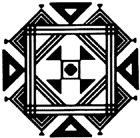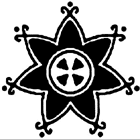 Clicking
on an image will open another window. You can use the second window
to scroll through all the enlarged images associated with this article
Clicking
on an image will open another window. You can use the second window
to scroll through all the enlarged images associated with this article |
The Henna Page Journal |
|
Childbirth and Postpartum Ritual Actions with Henna and Rangoli in Rural Rajasthan Postpartum practices in Rajasthan are typical of those throughout rural regions in India. |
 |
In rural Rajasthan, ritual actions surrounding childbirth include henna applications and rangoli[1]. A woman in the eighth month of her first pregnancy has an Athawansa ceremony. She rubbed with scented oils, bathed in perfumed water, and ornamented with henna, on her hands, feet, up to the wrist and ankle, in a manner similar to her wedding henna. She is dressed in new clothing and ornaments. She is seated on a cauki, ceremonial wooden seat. Women friends and family fill her lap (god) with sweets, fruit, and a coconut. This ritual is god bharna, or the filling of the lap. Women ornament the floor with rangoli called “Athvansa-ko-cowk” (Saksena 1979:121). The patterns used are acknowledged to bring health, protection and luck to the new mother and her child by inviting the aid of supernatural forces. Primiparous women are statistically most at risk for postpartum depression, and prenatal screenings for depression are often carried out in western medicine at this period (Stern and Kruckman, 1983). The eighth month ritual may serve to establish the woman’s “social safety net” within her community, who will help her through birth and reintegrate her after childbirth. The similarity of this henna to her wedding henna may remind her of the joyous occasion of her wedding, and raise her spirits if she has become anxious. Women are reminded that pregnancy and birth is the successful fulfillment of their marriage. At birthing, the mother is ornamented with henna before being escorted out of the delivery room. After the woman has given birth, she must have all of her fingernails and toenails hennaed in a ceremony known as Jalva Pujani, as henna is considered a medium for purging the pollution incurred from the process of giving birth (Saksena 1978, 75). If she is not properly hennaed at this time, she is considered at risk of not recovering from birth. For the first 9 days after birth, the woman is secluded and attended to by female relatives. The Rajasthani enforced rest, physical and emotional support during the establishment of maternal bonding and lactation may be crucial in preventing or relieving postpartum depression, and are similar to those observed in Nepal which are also considered to manage postpartum stress (Upreti, 1979) |
|
|
|||
| [Home] [How] [Why] [What] [Where] [FAQ] [Forum] | |||

